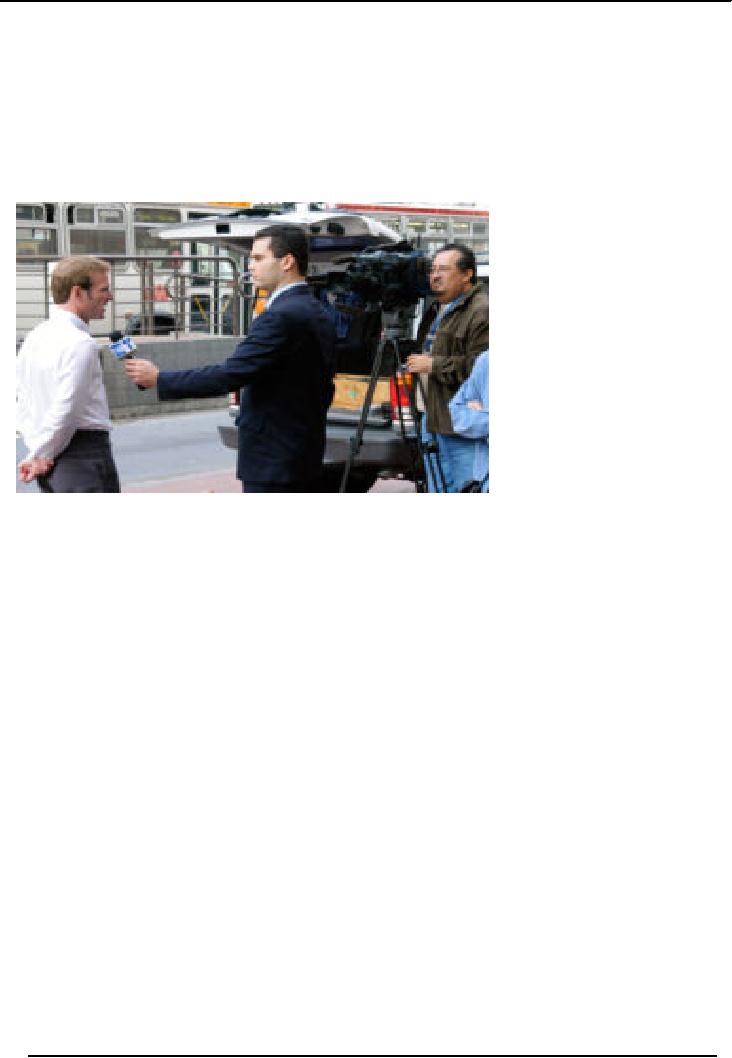 |
INTERVIEWS, VOX POPS AND PUBLIC OPINIONS:INTERVIEW, Information |
| << PREPARATION OF SPECIAL REPORTS:Uncovering Truth, Reportage |
| BACK GROUND VOICE AND VOICE OVER:Natural or Raw Sound, Sound Effects >> |

TV
News Reporting and Production MCM
516
VU
LESSON
36
INTERVIEWS,
VOX POPS AND PUBLIC OPINIONS
Setting
Up A Typical On-Location News
Interview
For
better or worse, interviews
are the basic staple of news
and documentaries.
There
are two basic ways of
handling an interview: one
designed for an extended interview
and
one
for a short interview segment, the
kind that is typical for TV
news.
1.
For
an extended interview you could
start out by lighting and
micing the set for the "A" and
"B"
camera
positions at the same time
and set up cameras in the A
and B.
The
position B camera can then
get close-up shots of the reporter and
over-the-shoulder shots with
the
back
of interview subject. Even when the
person being interviewed is speaking,
this will provide
reporter
reaction shots and shots
that can be used as insert
shots to cover edits in the dialogue of
the
person
being interviewed.
Camera
position A may be focused on the
person being interviewed and
provides the same type of
shots
from
this angle.
During
editing you always have the choice of
two camera angles, which
means you have much
more
creative
control. Even so, this
approach requires much more set-up time
for shooting the interview
and
editing
time to put it
together.
2.
For
a short interview it's easier
and takes less equipment to
first light and mic camera
position "A."
Then
after you get all of your
A-roll footage, move the
camera to position "B," mic
the reporter, and
move
your lights to the appropriate
position for this (reverse)
angle.
In
the latter case the camera is
first set up in position "A" and
focused on the interview subject.
The
reporter
asks all of his or her questions
and the responses are recorded on
what we've called an
"A-roll."
Note
that both close-ups and
over-the-shoulder shots are possible
from this angle.
Then
the camera is moved to position
"B." With the camera focused
on the reporter, all of the
questions
are
then asked over
again.
This
time, however, the interview subject
does not answer the questions. In
fact, if you can do
without
the
over-the-shoulder shots, the interview
subject doesn't even have to be there at all.
The reporter
simply
looks at a "spot on the wall"
behind where the person was
sitting and re-asks the
questions.
Remember
that a five- to eight-second pause
should separate each
question, especially if you
are using
videotape.
Reporter reaction shots or
"noddies," are also recorded
from this angle.
During
editing, the goal will be to
condense things as much as possible and
still remain true to
the
subject's
answers. When you cut out an
unnecessary segment of an answer, you
can cover the
resulting
jump
cut with a "noddie," an insert shot, or a
cutaway.
For
short questions, you might to opt to
eliminate the shot of the reporter and
simply use the audio
of
the
reporter's original question while
holding a shot on the person
being interviewed.
Sometimes
a reporter's question will be obvious in
an answer and you can save
time by not using the
question.
Remember, the faster you can move
things along without
sacrificing clarity, the
better.
One
of the most difficult aspects of
editing an interview, especially
when considerable editing and
rearranging
has to be done, is to achieve smooth
linking from one audio
segment to the next.
This
includes
preserving the brief pauses
that normally occur in
conversation.
Although
editing approaches differ,
for interviews most editors
first concentrate on audio. Once
they
have
a tightly edited "radio
program," they go back and cover the
video jump cuts with
insert shots,
reaction
shots, and cutaways.
119

TV
News Reporting and Production MCM
516
VU
Reporter's
Checklist
Broadcast
news is a highly competitive
business and in the rush to get a story
on the air it's
sometimes
tempting
to guess at facts or use
information from a questionable
source.
However,
errors in stories not only
damage a station's credibility but
they can derail a
reporter's
professional
future. Here are five
points to keep in mind when
writing news stories.
1.
Question
those who claim to be a witness to an
event and confirm that they
really were in a position
to
see what happened.
2.
Use
a second source to double-check
information that seems
surprising or may be in
doubt.
3.
Double-check
all names, titles, and
places, and, when necessary,
write out the pronunciation of
names
phonetically.
4.
When
writing the story, carefully
check spelling and grammar; do the math
on numbers.
5.
Make
sure that sound bites
selected during editing accurately
reflect what the person
meant.
News
Producer's Checklist
Once
reporters turn in their stories
and a news producer or director
takes over, many decisions
must still
be
made before the stories are
ready for broadcast.
Among
other things, the stories
must be reviewed for balance,
lead-ins (story introductions)
must be
written,
and appropriate graphics must be prepared to support
the stories.
Here
are five points that
should be considered before the newscast
goes on the air.
1.
Review
stories for a balance in
views, gaps, and missing
information.
2.
Double-check
phone numbers by calling them;
double-check web addresses by
visiting the sites.
(People
are known to get very upset
if their telephone number is erroneously
given out and they
have
noting
to do with the issue.)
3.
Check
graphics for accuracy.
4.
Make
sure the lead-ins to stories
and related news promos
accurately reflect the content and nature
of
the
stories.
5.
Step
back and view the overall
newscast and make sure
that the most important
stories of the day
have
been covered and that they accurately
reflect the most current
information and developments.
Do
reporters sometimes get things
wrong? Certainly. Not only
do they have human frailties, but
are
they
are fighting deadlines and constant
pressure to beat the
competition.
News
Bias
Conservatives
think that TV news has a
liberal bias and liberals
feel that news has a
conservative bias.
Being
a human endeavor, total objectively in
news is impossible, of course.
When you analyze bias
complaints
you are apt to conclude that
bias
is
defined as "any view that
differs from mine."
Although
the media is often seen as having a
liberal bias, it has been shown
that most of the
large
broadcast
operations are owned or managed by
individuals who, almost without
exception, hold views
that
are politically and socially to the
right of center.
Bias
can stem just as much
from what TV news reports as
what it doesn't
report.
When
it comes to politics, great effort
goes into trying to keep
certain things from becoming
public. For
example,
it has been well documented
that many embarrassing
government documents that have
nothing
to
do with national security
are marked "classified" simply to keep
the information from the
public.
To
help address this issue
The Freedom of Information Act
allows citizens and reporters access to
some
government
documents.
120

TV
News Reporting and Production MCM
516
VU
Although
the process of obtaining documents
can be fraught with red tape
and delays, and key
information
is often blacked out,
passage of The Freedom of Information
Act represented a major
step
forward
for investigative
journalism.
Various
independent agencies monitor the media
for bias.
INTERVIEW
An
interview
is
a conversation between two or more people
(the interviewer and the
interviewee)
where
questions are asked by the interviewer to
obtain information from the
interviewee. Interviews
can
be
divided into two rough
types, interviews of assessment and
interviews for
information.
Assessment
The
most common type of interview
for assessment is a job
interview between an employer and
an
applicant.
The goal of such an
interview is to assess a potential
employee to see if he/she
has the social
skills
and intelligence suitable for the
workplace. Similar interviews
are also used for
admissions to
schools,
allotment of grants, and other
areas.
In
most developed countries, rules and
regulations govern what can
be asked in these interviews.
Highly
personal
questions and those unrelated to the job
at hand are forbidden, as are questions
which invite
discrimination.
However some interviewers
tend to ask such questions in
order to see how the
interviewee
reacts and if (s)he is able
to elegantly avert the
question.
Information
The
second class of interviews
are those seeking to gather information
about a subject. These types of
interviews
are central to the practices
of journalism
and
instructional
design.
Such interviews are
also
important
to any non-fiction writer or
researcher. In general the quotes and
information gathered in
these
interviews are used in a
publication or edited for
broadcast.
Such
interviews occur only because the
subjects have some interest in being
interviewed. There are
four
main
reasons why subjects agree
to be interviewed:
Ego
-
The desire to be on television and to
have one's opinions aired is a strong
one-to-many. Many
people
enjoy talking about
themselves and their
lives.
Publicity
- Politicians
and celebrities are dependent on
publicity for their success
and an interview is
free
advertising. As such many
subjects insist upon
prominent mentions of their latest book
or movie in
the
interview. Such promotional
interviews are frequently
required by contracts.
Money
-
The issue of whether reporters
should pay for interviews is
a controversial one. Analysts and
experts
are almost always paid, and
this is often an important
source of income to them. Most
media
121

TV
News Reporting and Production MCM
516
VU
outlets
have rules against paying eyewitnesses
for interviews, in part
because this only encourages
the
fabrication
of fraudulent stories in the hopes of
being paid. A major
exception to this are some
tabloids,
especially
British tabloids. Other media
outlets often wine and dine
sought after subjects and give
them
other
such perks.
Helpfulness
-
many subjects agree to an
interview simply to help the
reporter. This is true of
most
eyewitnesses
and help explain why
many famous individuals
agree to grant interviews
for items such as
school
papers.
Even
after an interview has been
granted the subject normally imposes
conditions. Almost all
interviews
have
a time limit. The greater the fame
and importance of a subject the more
limitations they
demand.
These
includes subject matters that
are off limits, a veto
over the final piece, or even a
full list of
questions
provided in advance. Some
politicians, notably Helmut
Kohl (Germany), have avoided
giving
interviews
to the press, whereas many
others consider this a necessary
aspect of political
campaigning.
There
are several other rules to interviews. If
a subject declares that what
they say is "off
the record"
a
reporter
is not supposed to use such
information. If material is "Background"
the material can be
used
but
its source cannot be mentioned, if it is
"deep
background"
then the information cannot be used
on
its
own, and can only confirm
information already obtained
from another source. A subject may
also
declare
that their comments should
have no "attribution."
In such cases the name of the subject
cannot
be
mentioned, but they should
simply be referred to as "a source in
".
These
rules are unwritten and in the past
reporters have broken them. However if a
journalist published
material
that was off the record they
are unlikely to be able to
use that source again.
They are known as
a
"burnt
source."
Moreover news of such betrayals
spreads and a reporter may have
trouble with other
sources.
The
tone of an interviewer is also
important. Tough interviewers
that are honest and
forthrightly pose
important
and difficult questions are appealing to
audiences, but not to
subjects. An interviewer
that
develops
a reputation for such
aggressiveness may soon find
it difficult to convince subjects to
sit for an
interview.
A subject that is offended during an
interview may put an early
halt to the discussion.
Politicians,
celebrities, and experts on certain
subjects are frequently
interviewed. Sometimes
interviews
are
ended early (usually by the
interviewee). Well known
investigative
journalists can
often get
interviews
only under false pretenses.
Conversely, an interviewer that
asks only "soft" questions
will
lose
the respect of audiences and
colleagues.
The
ideal interview is considered to be a
face to face one. Most
newspapers order reporters to
specifically
mention that an interview
was conducted by telephone
or
e-mail.
122
Table of Contents:
- CREATIVITY AND IDEA GENERATION FOR TELEVISION:Video Procedures
- PRE-REQUISITES OF A CREATIVE PRODUCER/DIRECTOR:SET-UP RESPONSIBILITIES
- REFINING AN IDEA FOR PRODUCTION:Drama, Magazine Shows, Documentary
- CONCEPT DEVELOPMENT:Variable. Pure and applied research
- RESEARCH AND REVIEWS:Research Procedure, Review of available literature
- SCRIPT WRITING:Elements of a successful story, Characters, Effects
- PRE-PRODUCTION PHASE:Indoor production, Outdoor production, Essentials of PBE
- SELECTION OF REQUIRED CONTENT AND TALENT:Camera rehearsal
- PROGRAMME PLANNING:Checklist, Electronic Field Production (EFP)
- PRODUCTION PHASE:Floor plan, Traditional set, Representational set, Design elements
- CAMERA WORK:Movement of lens of camera, Types of shots
- LIGHT AND AUDIO:Importance of sound in TV, Use of microphone, Loudness
- DAY OF RECORDING/PRODUCTION:Rehearsals,Point to ponder
- LINEAR EDITING AND NLE:Episode, Scene, Editing, Production Switcher
- MIXING AND USES OF EFFECTS:Live Sound Effects, ARROW STRIKING
- SELECTION OF THE NEWS:Elements of news, Timeliness, proximity
- WRITING OF THE NEWS:The inverted pyramid, Lead, Credit line
- EDITING OF THE NEWS:Characteristics of good news:Process of editing a news
- COMPILATION OF NEWS BULLETIN:Hard news, Soft news, Investigative report
- PRESENTATION OF NEWS BULLETIN
- MAKING SPECIAL BULLETINS:Agriculture, Show biz, Fashion, Drama
- TECHNICAL CODES, TERMINOLOGY, AND PRODUCTION GRAMMAR
- TYPES OF TV PRODUCTION:Magazine Shows, Specific audience programming
- DRAMA AND DOCUMENTARY:Documentary film, Defining documentary
- SOURCES OF TV NEWS:Reporters, Correspondents, Monitoring, News Agency
- FUNCTIONS OF A REPORTER
- BEATS OF REPORTING:City reporter, Social reporters, Show-biz reporter
- STRUCTURE OF NEWS DEPARTMENT:Beat Reporters, Online media
- ELECTRONIC FIELD PRODUCTION:Sports, Electronic news gathering
- LIVE TRANSMISSIONS:Studio floor, Switcher, Master control room, Camera control units
- QUALITIES OF A NEWS PRODUCER:Determination, Awareness, Sharp an active
- DUTIES OF A NEWS PRODUCER
- ASSIGNMENT/NEWS EDITOR:Accuracy, Fairness and Reliability, Conflict
- SHOOTING A NEWS FILM:The Influence of telecast News
- PREPARATION OF SPECIAL REPORTS:Uncovering Truth, Reportage
- INTERVIEWS, VOX POPS AND PUBLIC OPINIONS:INTERVIEW, Information
- BACK GROUND VOICE AND VOICE OVER:Natural or Raw Sound, Sound Effects
- SPOKEN WORDS AND RELEVANT VISUALS:Digital Audio, Quantizing Error
- TALK SHOWS, FORUMS AND DISCUSSION PROGRAMMES
- FUNCTIONS OF VARIOUS DEPARTMENTS OF A TV SET UP
- PROGRAMMES DEPARTMENT:Program content, Television series by genre
- NEWS AND CURRENT AFFAIRS THE PROGRAMMING & SCHEDULING
- COORDINATION AMONG DIFFERENT DEPARTMENTS OF TELEVISION
- COORDINATION AMONG DIFFERENT DEPARTMENTS OF TELEVISION - 2 SUB-DEPARTMENTS AND SMALL SECTIONS
- COORDINATION AMONG DIFFERENT DEPARTMENTS OF TELEVISION 3